Practice Free AZ-800 Exam Online Questions
You need to ensure that access to storage1 for the Marketing OU users meets the technical requirements.
What should you implement?
- A . Microsoft Entra Connect cloud sync
- B . Active Directory Federation Services (AD FS)
- C . Microsoft Entra Connect in staging mode
- D . Microsoft Entra Connect in active mode
You need to ensure that Automanage meets the technical requirements.
On which Azure virtual machines should you enable Automanage?
- A . Server1 only
- B . Server2 only
- C . Server1 and Server2 only
- D . Server2 and Server3 only
- E . Server1 and Server4 only
Your network contains an Active Directory Domain Services (AD DS) domain. The domain contains a user named User1. User1 is a member of a group named Group1 and is in an organizational unit (OL)} named OU1.
The domain has minimum password lengths configured as shown in the following table.

What is the minimum password length that User1 should use when changing to a new password?
- A . 7
- B . 8
- C . 10
- D . 12
- E . 14
HOTSPOT
You have a server named Server1 that runs Windows Server.
Server1 has a single network interface and the Hyper-V virtual switches shown in the following exhibit.
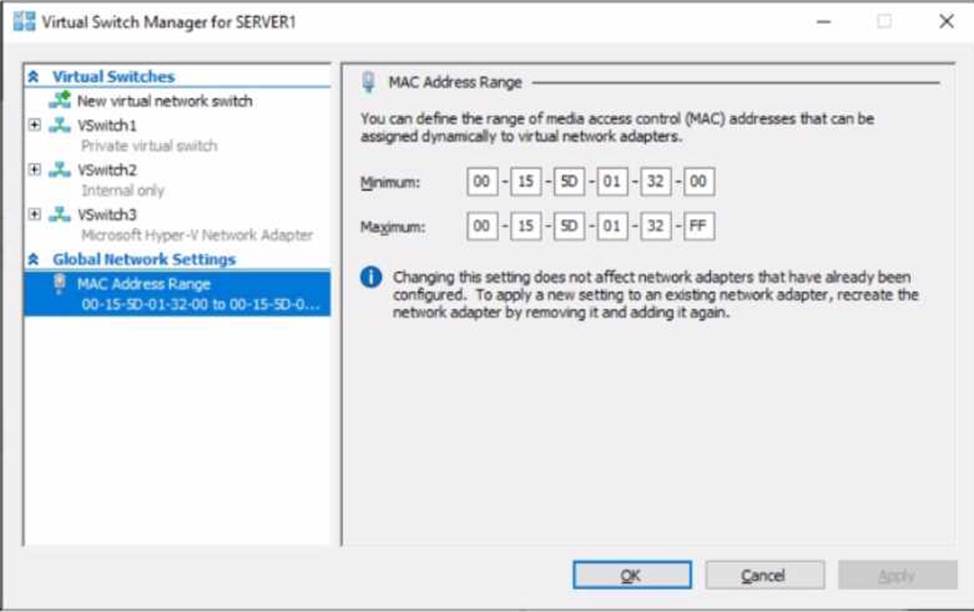
Use the drop-down menus to select the answer choice that completes each statement based on the information presented in the graphic. NOTE: Each correct selection is worth one point.
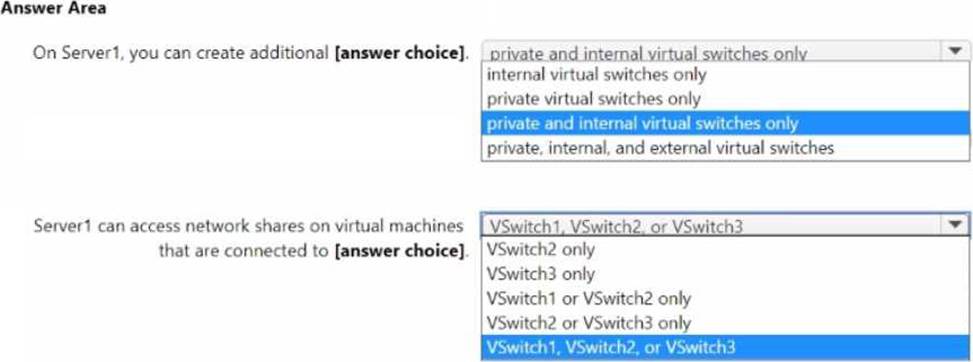
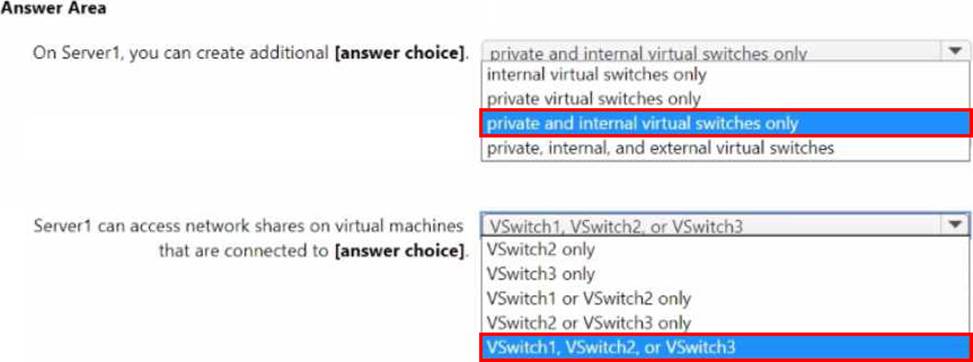
You have an Azure virtual machine named Served that runs a network management application.
Server1 has the following network configurations:
• Network interface: Nic1
• IP address. 10.1.1.1/24
• Connected to: VnetVSubnet1
You need to connect Server1 to an additional subnet named Vnet1/Subnet2.
What should you do?
- A . Modify the IP configurations of Nic1.
- B . Add a network interface to Server1.
- C . Add an IP configuration to Nic1.
- D . Create a private endpoint on Subnet2
You haw? a server named Host! that has the Hyper-V server role installed. Host! hosts a virtual machine named VM1.
You have a management server named Server! that runs Windows Server. You remotely manage Host1 from Server1 by using Hyper-V Manager.
You need to ensure that you can access a USB hard drive connected to Server1 when you connect to VM1 by using Virtual Machine Connection.
Which two actions should you perform? Each correct answer presents part of the solution. NOTE: Each correct selection is worth one point.
- A . From the Hyper-V Settings of Host1, select Allow enhanced session mode
- B . From Disk Management on Host1. attach a virtual hard disk.
- C . From Virtual Machine Connection, switch to a basic session.
- D . From Virtual Machine Connection select Show Options and then select the USB hard drive.
- E . From Disk Management on Host1, select Rescan Disks
A, D
Explanation:
Reference: https://docs.microsoft.com/en-us/windows-server/virtualization/hyper-v/learn-more/use-local-resources-on-hyper-v-virtual-machine-with-vmconnect
HOTSPOT
Your network contains two Active Directory forests and a domain trust as shown in the following exhibit.
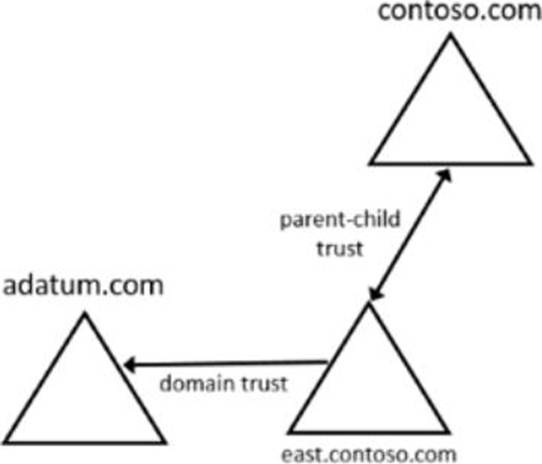
The domain trust has the following configurations:
• Name: adatum.com
• Type: External
• Direction: One-way. outgoing
• Outgoing trust authentication level: Domain-wide authentication
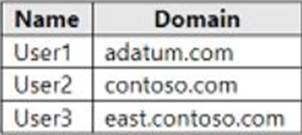
The forests contain the network shares shown in the following table.

For each of the following statements, select Yes if the statement is true. Otherwise, select No. NOTE: Each correct selection is worth one point.

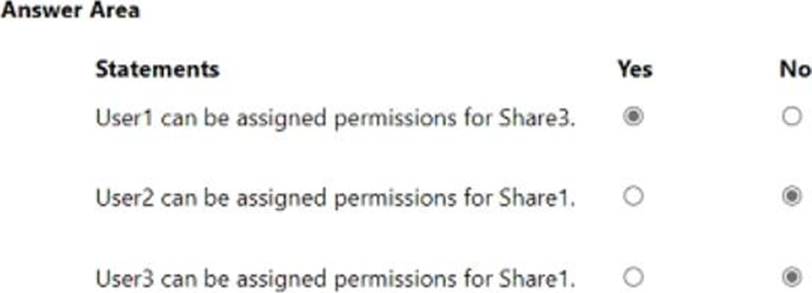
You have an on-premises Active Directory Domain Services (AD DS) domain that syncs with an Azure Active Directory (Azure AD) tenant Group writeback is enabled in Azure AD Connect.
The AD DS domain contains a server named Server1 Server 1 contains a shared folder named share1. You have an Azure Storage account named storage2 that uses Azure AD-based access control. The storage2 account contains a share named shared
You need to create a security group that meets the following requirements:
• Can contain users from the AD DS domain
• Can be used to authorize user access to share 1 and share2
What should you do?
- A . in the AD DS domain, create a universal security group
- B . in the Azure AD tenant create a security group that has assigned membership
- C . in the Azure AD Tenant create a security group that has dynamic membership.
- D . in the Azure AD tenant create a Microsoft 365 group
You have an Azure virtual machine named VM1 that contains the drives shown in the following table.
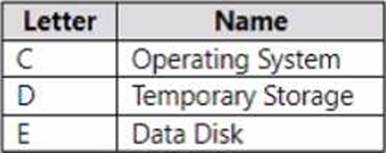
On VM1, you plan to install an app named App1. The data for App1 must be stored on a persistent data disk assigned to drive D.
You need assign the data disk to drive D.
What should you do on VM1 first?
- A . Change the drive letter of the Temporary Storage drive to F.
- B . Move pagefile.sys to the Operating System drive.
- C . Stop (deallocate) VM1.
- D . Expand the Temporary Storage drive.
You have four testing devices that are configured with static IP addresses as shown in the following table.
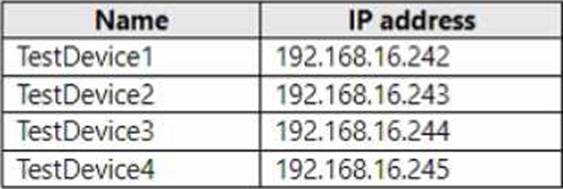
The test devices are turned on once a month.
You need to prevent Server1 from assigning the IP addresses allocated to the test devices to other devices when the test devices are offline. The solution must minimize administrative effort.
What should you do?
- A . Create an exclusion range.
- B . Create reservations.
- C . Configure the Scope options.
- D . Create a policy.
